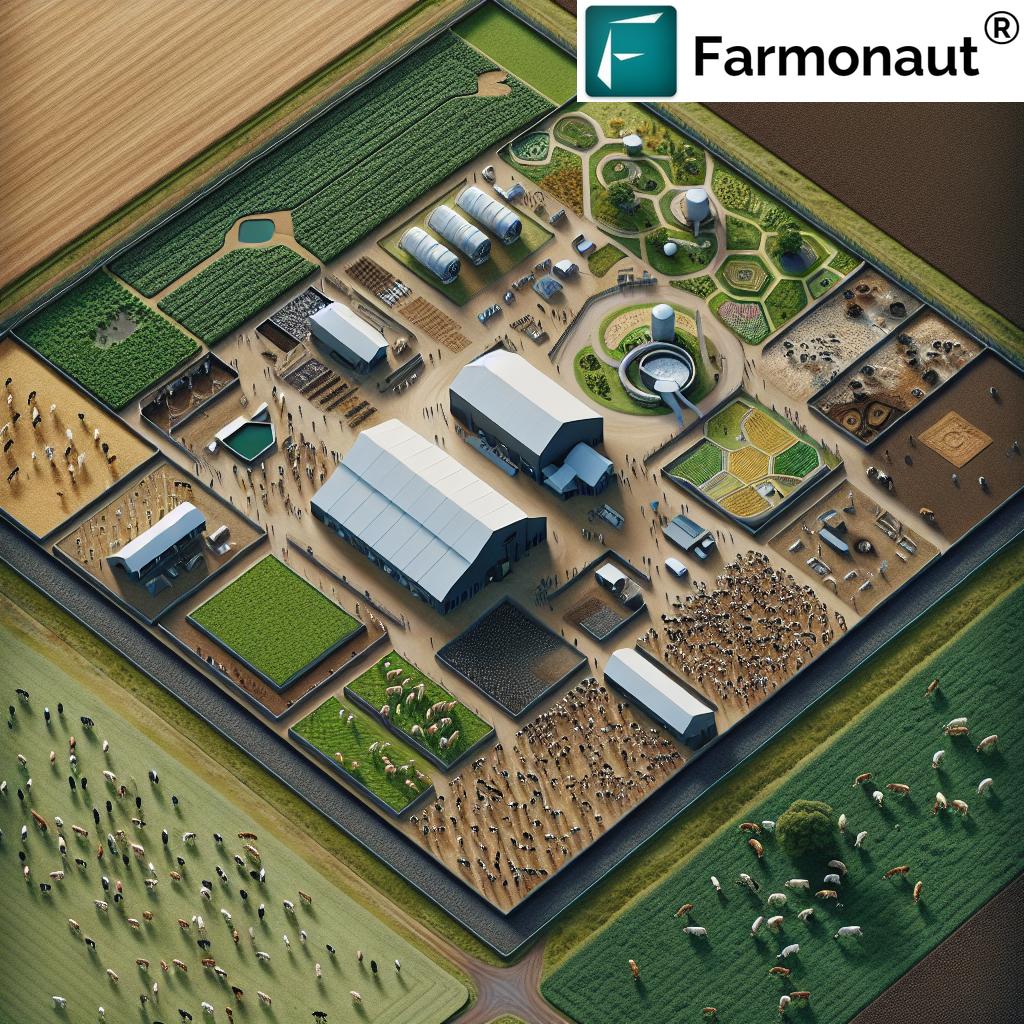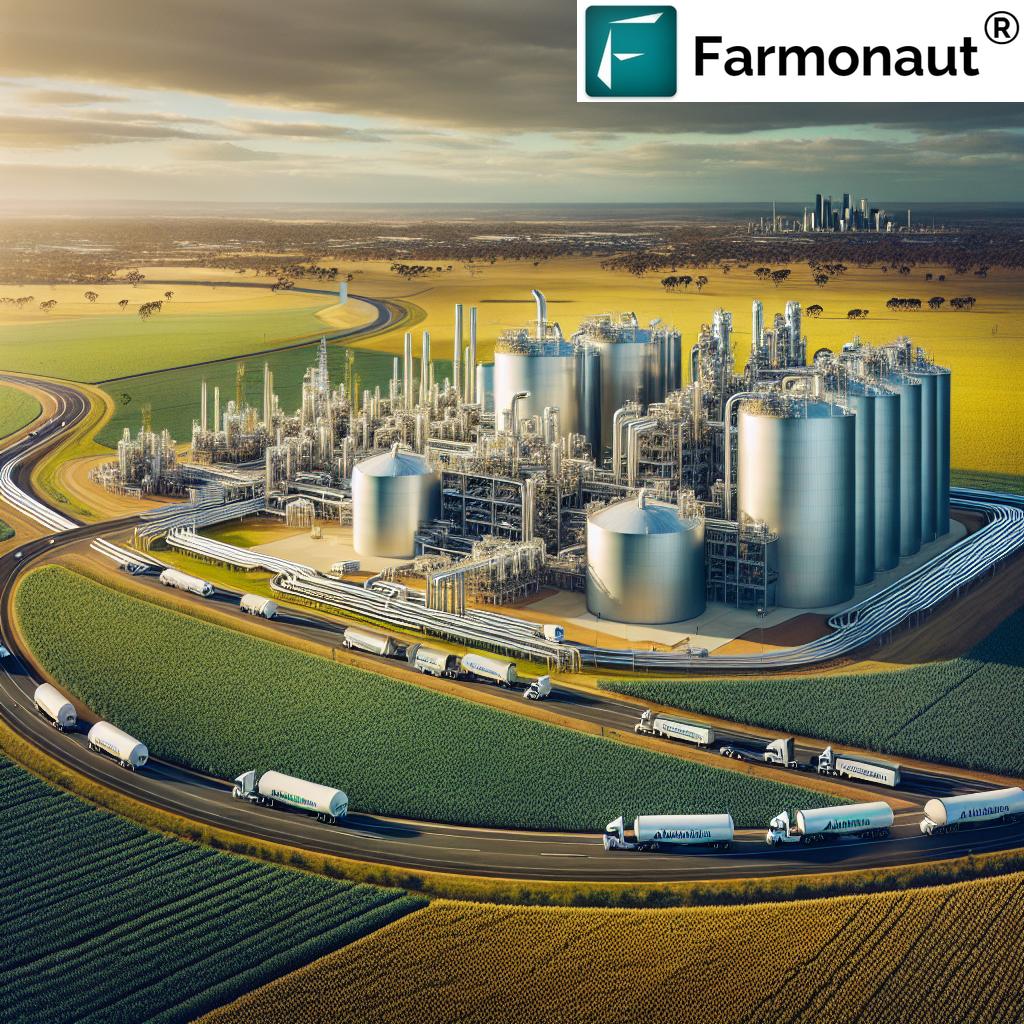Mastering Dairy Barn Planning: Essential Tips for Victorian Farmers’ Success in Agricultural Infrastructure Development

“Victorian dairy farmers can increase milk production by up to 20% through strategic housed-cow system implementation.”
Welcome to our comprehensive guide on mastering dairy barn planning for Victorian farmers. In this article, we’ll explore essential tips and strategies for success in agricultural infrastructure development, with a focus on dairy farming innovations and sustainable agriculture practices. As the agricultural landscape evolves, it’s crucial for farmers to stay informed about the latest trends and technologies that can enhance their operations.
At Farmonaut, we understand the challenges faced by dairy farmers in Victoria and across Australia. Our mission is to provide cutting-edge solutions that make precision agriculture accessible and affordable. Through our satellite-based farm management platform, we offer valuable insights that can help you optimize your dairy operations and make informed decisions about barn planning and farm expansion.
The Importance of Strategic Dairy Barn Planning
Effective dairy barn planning is a cornerstone of successful agricultural infrastructure development. It not only impacts the day-to-day operations of your farm but also plays a crucial role in long-term sustainability and profitability. Here are some key reasons why strategic planning is essential:
- Improved animal welfare and comfort
- Enhanced milk production and quality
- Increased operational efficiency
- Better resource management
- Compliance with regulatory requirements
- Future-proofing your farm for growth
As we delve deeper into the various aspects of dairy barn planning, keep in mind that each decision you make can have far-reaching consequences for your farm’s success.
Site Selection and Environmental Considerations
Choosing the right location for your dairy barn is a critical first step in the planning process. Consider the following factors when selecting your site:
- Topography and drainage
- Proximity to water sources
- Soil quality and stability
- Access to utilities and infrastructure
- Potential for future expansion
- Environmental impact and regulations
At Farmonaut, we offer satellite-based crop health monitoring that can provide valuable insights into land conditions. Our technology can help you assess soil moisture levels and other critical metrics, ensuring you make an informed decision about your barn’s location.
Explore our satellite monitoring capabilities: 
Regulatory Compliance and Approval Process
Navigating the regulatory landscape is one of the most challenging aspects of dairy barn planning. Victorian farmers must comply with various local, state, and federal regulations. Here’s a brief overview of the approval process:
- Research applicable zoning laws and building codes
- Prepare comprehensive plans and documentation
- Submit applications to relevant authorities
- Engage with the community and address concerns
- Respond to feedback and make necessary adjustments
- Obtain final approvals and permits
“Effective dairy barn planning can reduce regulatory approval time by 30%, accelerating farm expansion projects.”
To streamline this process, consider working with experienced professionals who understand the local regulatory environment. Farmonaut’s technology can also assist in providing accurate data for your applications, particularly in areas such as land use and environmental impact assessments.
Innovative Barn Design for Optimal Performance
Modern dairy barn design focuses on creating an environment that maximizes cow comfort and productivity while minimizing labor requirements. Here are some key elements to consider:
- Ventilation systems for temperature and humidity control
- Flooring materials that promote hoof health
- Efficient manure management systems
- Comfortable bedding areas
- Strategic placement of feeding and watering stations
- Advanced milking parlor design
Incorporating these elements into your barn design can lead to significant improvements in milk production and animal welfare. Farmonaut’s AI-powered advisory system, Jeevn AI, can provide personalized recommendations for optimizing your barn’s layout based on data-driven insights.
Sustainable Agriculture Practices in Dairy Farming
Implementing sustainable agriculture practices is not only environmentally responsible but can also lead to long-term cost savings and improved farm performance. Consider the following strategies:
- Water conservation through rainwater harvesting and recycling
- Energy-efficient lighting and equipment
- Renewable energy sources such as solar panels
- Waste management and composting systems
- Precision feeding to reduce nutrient waste
- Implementation of rotational grazing practices
Farmonaut’s platform includes features for carbon footprint tracking, allowing you to monitor and reduce your environmental impact. This data can be invaluable for making sustainable decisions and potentially accessing green financing options.
Download our mobile apps for on-the-go farm management:
Effluent Management and Water Conservation
Proper effluent management is crucial for environmental compliance and can provide valuable nutrients for pasture growth. Consider these aspects when planning your effluent system:
- Storage capacity based on herd size and rainfall patterns
- Efficient collection and distribution methods
- Treatment options for reducing nutrient load
- Strategic application of effluent to pastures
- Monitoring systems to prevent overflows and contamination
Farmonaut’s satellite monitoring can help you identify optimal areas for effluent application and track the impact on crop health, ensuring you maximize the benefits while minimizing environmental risks.
Community Engagement and Neighbor Relations
Building positive relationships with your local community is essential for the long-term success of your dairy operation. Here are some strategies for effective community engagement:
- Organize open house events to showcase your farm
- Participate in local agricultural events and fairs
- Communicate transparently about your plans and operations
- Address concerns proactively and respectfully
- Collaborate with local schools for educational programs
- Support community initiatives and charities
By fostering good relationships with your neighbors and the broader community, you can create a supportive environment for your farm’s growth and development.
Technology Integration in Modern Dairy Barns
Embracing agricultural technology is key to staying competitive in the modern dairy industry. Consider integrating these technologies into your barn design:
- Automated milking systems
- Robotic feed pushers and cleaners
- Smart collars for health and activity monitoring
- Climate control systems with real-time adjustments
- Data management platforms for performance tracking
Farmonaut’s platform can seamlessly integrate with many of these technologies, providing a centralized hub for data analysis and decision-making. Our API allows for easy data exchange between different systems, enhancing the overall efficiency of your operation.
Explore our API capabilities: Farmonaut API
For developers: API Developer Docs
Financial Planning and Business Development
A robust financial plan is crucial for the success of your dairy barn project. Consider these elements when developing your business plan:
- Detailed cost estimates for construction and equipment
- Projected revenue based on increased production capacity
- Operational costs including labor, feed, and utilities
- Financing options and repayment schedules
- Risk assessment and mitigation strategies
- Long-term growth projections and expansion plans
Farmonaut’s data-driven insights can help you make more accurate financial projections by providing real-time information on crop health, weather patterns, and market trends. This can be invaluable when seeking financing or planning for future investments.
Workforce Planning and Training
As you expand your dairy operation, consider the following aspects of workforce planning:
- Assess skill requirements for new technologies
- Develop comprehensive training programs
- Create clear roles and responsibilities
- Implement safety protocols and procedures
- Foster a positive work culture
- Plan for succession and knowledge transfer
Investing in your workforce is crucial for the successful implementation of your new dairy barn and associated technologies. Farmonaut offers training resources to help your team make the most of our satellite monitoring and AI advisory systems.

Dairy Industry Trends and Future Outlook
Staying informed about industry trends is crucial for long-term success. Here are some key trends shaping the future of dairy farming in Victoria:
- Increasing consumer demand for sustainable and ethical practices
- Growing interest in value-added dairy products
- Adoption of precision agriculture techniques
- Focus on animal welfare and antibiotic-free production
- Exploration of alternative protein sources
- Emphasis on traceability and transparency in the supply chain
Farmonaut’s blockchain-based traceability solutions can help you meet the growing demand for transparency in the dairy industry, providing verifiable data on your production practices and product journey.
Dairy Barn Planning Checklist
| Planning Stage | Key Considerations | Potential Challenges | Expert Tips |
|---|---|---|---|
| Site Selection | Topography, drainage, soil quality | Environmental restrictions, land availability | Use satellite data to assess land conditions |
| Regulatory Compliance | Zoning laws, building codes, permits | Complex approval process, delays | Engage with authorities early in the process |
| Infrastructure Design | Ventilation, flooring, milking systems | Balancing cost with efficiency | Prioritize cow comfort for optimal production |
| Effluent Management | Storage capacity, treatment options | Compliance with environmental regulations | Implement advanced monitoring systems |
| Community Engagement | Open communication, addressing concerns | Resistance from neighbors | Host farm tours to build understanding |
| Business Plan Development | Financial projections, risk assessment | Securing financing, market volatility | Use data-driven insights for accurate forecasting |
Conclusion: Embracing the Future of Dairy Farming
As we’ve explored throughout this guide, successful dairy barn planning requires a holistic approach that considers everything from site selection to technology integration and community relations. By implementing these strategies and leveraging advanced tools like those offered by Farmonaut, Victorian dairy farmers can position themselves for long-term success in an evolving industry.
Remember, effective planning is an ongoing process. Continuously monitor your operations, stay informed about industry trends, and be willing to adapt your strategies as needed. With the right approach and tools, you can create a dairy operation that is not only profitable but also sustainable and community-friendly.
At Farmonaut, we’re committed to supporting farmers like you with cutting-edge technology and data-driven insights. Our satellite-based farm management solutions can help you optimize every aspect of your dairy operation, from crop health monitoring to resource management and sustainability tracking.
Farmonaut Subscription Plans
Frequently Asked Questions
Q: How can Farmonaut’s technology benefit my dairy farm?
A: Farmonaut offers satellite-based crop health monitoring, AI-driven advisory systems, and resource management tools that can help optimize your dairy operations. Our technology provides real-time insights into land conditions, crop health, and weather patterns, enabling more informed decision-making for farm management.
Q: What factors should I consider when selecting a site for my new dairy barn?
A: Key factors include topography, drainage, soil quality, proximity to water sources, access to utilities, potential for future expansion, and environmental regulations. Farmonaut’s satellite monitoring can assist in assessing land conditions and suitability.
Q: How can I streamline the regulatory approval process for my dairy barn project?
A: Research applicable regulations early, prepare comprehensive documentation, engage with authorities proactively, and address community concerns. Farmonaut’s data can support your applications with accurate land use and environmental impact assessments.
Q: What are some innovative technologies I should consider for my new dairy barn?
A: Consider automated milking systems, robotic feed management, smart collars for health monitoring, climate control systems, and data management platforms. Farmonaut’s API can integrate with many of these technologies to provide centralized data analysis.
Q: How can I make my dairy operation more sustainable?
A: Implement water conservation measures, use energy-efficient equipment, consider renewable energy sources, optimize waste management, and use precision feeding techniques. Farmonaut’s platform includes carbon footprint tracking to help monitor and reduce your environmental impact.
We hope this guide has provided valuable insights for your dairy barn planning journey. Remember, successful agricultural infrastructure development is a complex process, but with careful planning and the right tools, you can create a thriving, sustainable dairy operation that meets the challenges of today and tomorrow.



















